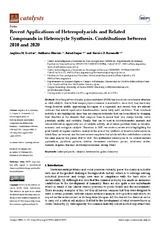Recent Applications of Heteropolyacids and Related Compounds in Heterocycle Synthesis. Contributions between 2010 and 2020
Autor
Escobar, Angélica M.
Blustein, Guillermo
Luque, Rafael
Romanelli, Gustavo P.
Editor
MDPIFecha
2021Materia
HeteropolyacidsCatalysis
Heterocycles
Green chemistry
METS:
Mostrar el registro METSPREMIS:
Mostrar el registro PREMISMetadatos
Mostrar el registro completo del ítemResumen
Over the past two decades, polyoxometalates (POM) have received considerable attention as solid catalysts, due to their unique physicochemical characteristics, since, first, they have very strong Bronsted acidity, approaching the region of a superacid, and second, they are efficient oxidizers that exhibit rapid redox transformations under fairly mild conditions. Their structural mobility is also highlighted, since they are complex molecules that can be modified by changing their structure or the elements that compose them to model their size, charge density, redox potentials, acidity, and solubility. Finally, they can be used in substoichiometric amounts and reused without an appreciable loss of catalytic activity, all of which postulate them as versatile, economic and ecological catalysts. Therefore, in 2009, we wrote a review article highlighting the great variety of organic reactions, mainly in the area of the synthesis of bioactive heterocycles in which they can be used, and this new review completes that article with the contributions made in the same area for the period 2010 to 2020. The synthesized heterocycles to be covered include pyrimidines, pyridines, pyrroles, indoles, chromenes, xanthenes, pyrans, azlactones, azoles, diazines, azepines, flavones, and formylchromones, among others.

